Recommendations for taking cabergoline
Description
Cabergoline is a prescription medication that belongs to a class of drugs known as dopamine agonists. It is commonly used to treat a variety of medical conditions, ranging from high levels of prolactin in the blood, to hyperprolactinemia, to Parkinson’s disease, and more. Cabergoline is a unique medication in that it works to balance the amount of serotonin and dopamine that is present in the body to help eliminate any undesirable symptoms. As a dopamine-based medication, Cabergoline can be used to help eliminate many of the symptoms associated with problems stemming from an imbalance in serotonin and dopamine.
Recommended Dosage of Cabergoline
Cabergoline is available in tablet form and is generally prescribed in the following doses:
- For the treatment of Parkinson’s disease, the recommended dosage is 0.5 mg twice per week.
- For the treatment of hyperprolactinemia, the recommended dosage is 0.25 mg twice per week.
- For the treatment of infertility, the recommended dosage is 0.5 to 1 mg twice per week.
- It is important to note that the dosage of cabergoline may vary from person to person depending on their age and medical condition.
It may take two to three weeks to experience the full effect of cabergoline. It is important not to exceed the maximum dosage of cabergoline as prescribed by the doctor or as mentioned in the patient information leaflet.
Benefits of Cabergoline
Here are some of the benefits of cabergoline:
- Cabergoline is an effective and approved treatment for Parkinson’s disease.
- It is a safe and effective treatment for hyperprolactinemia.
- It can be used to treat fertility issues in both men and women.
- It is relatively safe and has few side effects.
Indications for Cabergoline
Cabergoline is a medication used to treat a wide range of medical conditions, including hyperprolactinemia, valvular heart disease, and Parkinson’s disease. It is also used to reduce the risk of ovarian hyperstimulation syndrome and reduce the risk of uterine and ovarian cancer due to increased levels of prolactin. This article explores the indications for cabergoline usage in greater detail.
Hyperprolactinemia
The primary indication for cabergoline usage is hyperprolactinemia. This is a condition characterized by high levels of prolactin – a hormone released by the pituitary gland that stimulates milk production. Hyperprolactinemia is usually caused by a tumor known as a prolactinoma, which is located in the pituitary gland. Common symptoms associated with hyperprolactinemia include abnormal breast growth, a decrease in libido, menstrual irregularities, infertility, and headaches.
Cabergoline is a preferred treatment for patients with hyperprolactinemia. According to a study published in “The Journal of Clinical Endocrinology & Metabolism”, cabergoline can reduce prolactin levels by 27–58% within 1–7 weeks. In addition, cabergoline has also been shown to reduce tumor size in some cases.
Valvular Heart Disease
Another indication of cabergoline is to treat patients with valvular heart disease. This refers to any disease that affects the valves of the heart. Valvular heart disease can lead to a number of serious complications, such as heart failure, stroke, and infection of the lining of the heart (endocarditis).
Cabergoline has been shown to reduce the risk of developing valvular heart disease by as much as 50%. In addition, cabergoline has also been shown to reduce the severity of symptoms in patients with existing valvular heart disease. A study published in “The Annals of Thoracic Surgery” found that cabergoline reduced symptoms such as dyspnea (shortness of breath) by up to 65%.
Parkinson’s Disease
Cabergoline is also used to treat Parkinson’s disease, a degenerative neurological disorder that affects movement, balance, and coordination. Common symptoms of Parkinson’s disease include tremors, stiffness, and slowed movement. Cabergoline has been shown to reduce the severity of these symptoms in some cases.
A study published in “The Journal of Parkinson’s Disease” found that cabergoline reduced symptoms of Parkinson’s disease by 29% after 8 weeks of treatment. Additionally, another study found that cabergoline improved quality of life scores in patients with Parkinson’s disease by up to 39%.
Summary
In summary, cabergoline is an effective treatment for a variety of medical conditions, including hyperprolactinemia, valvular heart disease, and Parkinson’s disease. It has been shown to reduce symptoms and improve quality of life in patients with these conditions. Those considering cabergoline for treatment should speak to a medical professional for further advice.
Potential Side Effects
Cabergoline is generally considered safe, although some people have reported experiencing side effects while taking the medication, such as fatigue, nausea, constipation, vomiting, light-headedness, and headache. In rare cases, cabergoline can cause serious side effects, such as lung inflammation, heart valve damage, and changes in heart rhythm. People taking cabergoline should consult their doctor immediately if they experience any of these symptoms, as they can be very dangerous if not treated promptly.
Conclusion
Cabergoline is a commonly prescribed medication that works to increase levels of serotonin and dopamine in the body, and is often used to treat a variety of medical conditions, ranging from infertility to Parkinson’s disease. It is important to note that while cabergoline is generally considered safe, some people have reported experiencing potential side effects from taking the medication. It is important to consult a doctor before taking cabergoline, as it can potentially have serious side effects, and to monitor any symptoms while taking the medication.
Showing 1–16 of 18 results
-

Agalates 0,5 mg (2 tab) TEVA
7,00 € Add to cart -
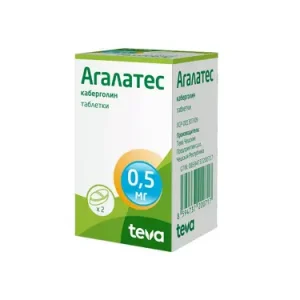
Agalates 0,5 mg (8 tab) TEVA
10,86 € Add to cart -

Bergolac 0,5 mg (2 tab) Veropharm LLC
5,00 € Add to cart -

Bergolac 0,5 mg (8 tab) Veropharm LLC
25,80 € Add to cart -
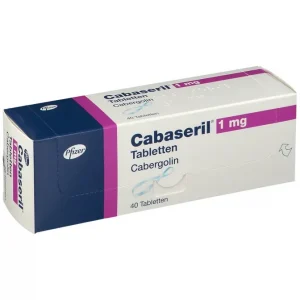
Cabaseril® 1 mg Pfizer
10,00 € Add to cart -
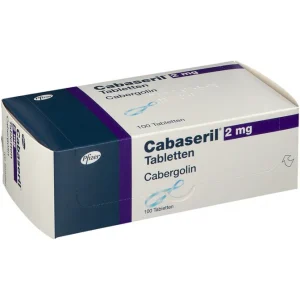
Cabaseril® 2 mg Pfizer
10,00 € Add to cart -

Cabergolin 0.5 mg (2 tab) Obninsk
4,00 € Add to cart -

Cabergolin 0.5 mg (8 tab) Obninsk
15,00 € Add to cart -

Cabergolin-ratiopharm® 0.5 mg
9,86 € Add to cart -
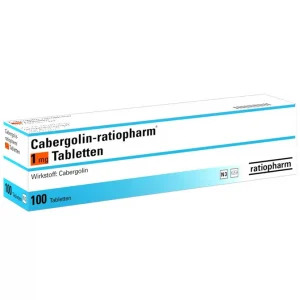
Cabergolin-ratiopharm® 1 mg
10,00 € Add to cart -

Cabergolin-ratiopharm® 2 mg
10,00 € Add to cart -

Cabergolin-TEVA® 0,5 mg
9,86 € Add to cart -
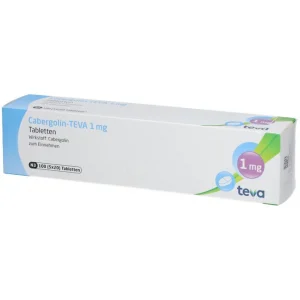
Cabergolin-TEVA® 1 mg
10,00 € Add to cart -

Cabergolin-TEVA® 2 mg Teva
10,00 € Add to cart -

Dostinex 0,5 mg (2 tab) Pfizer
9,00 € Add to cart -

Dostinex 0,5 mg (8 tab) Pfizer
22,75 € Add to cart